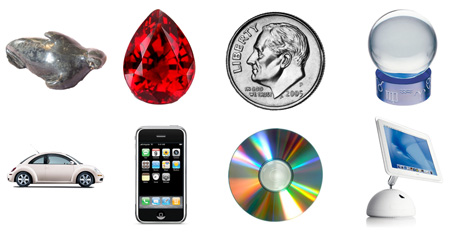Theory of the Precious Object
Some years ago I developed a crackpot idea I call The Theory Of The Precious Object.
 This theory is based on the following observations:
This theory is based on the following observations:
- Crows, racoons and other animals are known to be attracted to shiny objects.
- Many products which succeed in the marketplace resemble the objects which attract these animals.
- Our attraction to these shiny objects is not always entirely rational.
My hypothesis is that the brain is hardwired in a very fundamental way to be favorably disposed to certain kinds of objects. We contain, within us, an ideal object, or archetype, which we compare other objects to. The closer things are to this ideal object, the more likely we are to desire them, and the more precious they are to us.
A precious object is any object which has most (if not all) of the following five properties.
 It is small.
It is small.
It is shiny.
It is round.
It is hard.
It is simple.
Here are some precious objects from the past and present. I’m sure you can think of a few others.

Once you start thinking about precious objects, you’ll start to notice them everywhere. There are whole catalogs devoted to them. There are stories about them, and movies.
Here’s a bit more thinking about the five properties of precious objects.
It is small.
Obviously, a Volkswagen is larger than a diamond. I would say a Precious Object is small for it’s class.
It is shiny.
All the precious objects I have identified have a glossy or shiny aspect to them. One of the better examples of this is the Audio CD. I am convinced that a big reason for the rapid success of the CD in the 1980s (over vinyl and cassette) was not that it was digital, but that it was small, and irridescently shiny. If the CD had more closely resembled a vinyl record, I do not think it would have succeeded so quickly.
It is round.
Not all precious objects are perfectly round, but most of them are exhibit symmetry, and often radial symmetry — I use “round” as a placeholder for “exhibits high degrees of symmetry”. When we prepare gems for market, the biggest change we make to them is to render them symmetrical. Why do we do this? Doesn’t it technically make the diamond less valuable to cut chips off of it? We do it because it makes the diamond more precious in our minds.
It is hard.
I haven’t been able to identify any soft precious objects. Perhaps one reason is that pliability tends to have an effect on the shape of an object, making it less symmetrical.
It is simple.
Clearly a Volkswagen is not a simple object, but all precious objects, including the Beetle convey an outward simplicity, compared to the not-so-precious objects they contend with in the marketplace. Compare a regular cell phone (itself a precious object at one time) to the IPhone. Turned off, the original IPhone is just a glass and metal slab. No buttons.
So how can we benefit from this theory? There are two ways. As product designers and marketers, we can work to insure our products meet these desirable qualities. Some companies are already very good at this, you may have noticed.
Secondly, as consumers, we can recognize that our desire and attachment for small shiny objects is ultimately irrational — it is an aspect of our animal brains. More often than not, the joy these objects bring into our lives has more to do with the status conferred by possessing them, rather than their actual function. Or perhaps we can say that their preciousness is their function.

